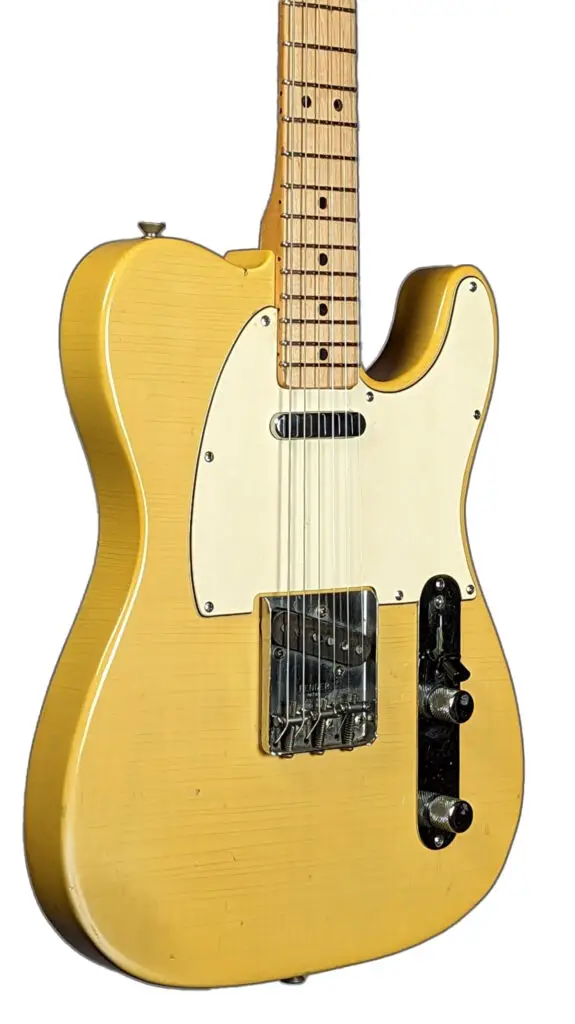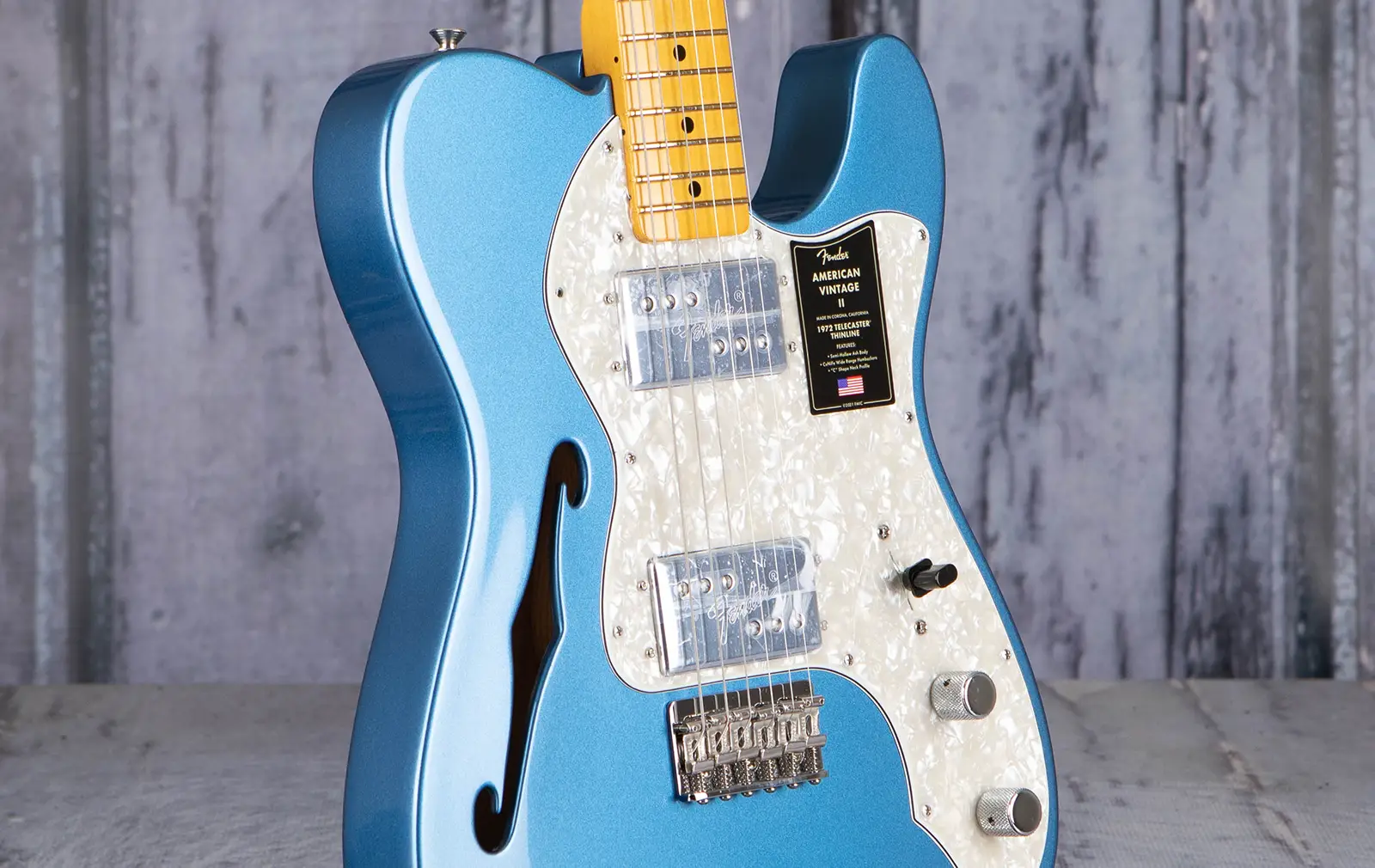In the broad universe of guitars, the Thinline holds a distinctive place.
Characterized by their reduced body depth, Thinline guitars offer a unique blend of comfort, lightweight design, and tonal characteristics that set them apart from their full-bodied counterparts.
What is a thinline guitar?
A thinline guitar is a type of guitar, either electric or acoustic, characterized by a thinner body depth than traditional models, designed to reduce weight and improve player comfort. Despite the reduced body size, these guitars still aim to deliver a rich and full sound, although the tone can vary.
Whether you’re a seasoned guitarist or a beginner looking to understand more about different types of guitars, this article will guide you through the nuances of Thinline guitars.
We will look into what defines a Thinline, explore the differences between Thinline electric and acoustic guitars, and specifically look at the iconic Thinline version of the Fender Telecaster. By the end, you’ll have a comprehensive understanding of Thinline guitars and what makes them a cherished choice for many musicians.
Read on to discover more about these fascinating guitars.

What Is A Thinline Guitar?
A thinline guitar is a type of guitar that has a thinner body depth than traditional models. They were designed to reduce the weight of the instrument and improve player comfort. The term “thinline” was initially popularized by guitar manufacturer Gibson in the late 1950s, with models like the ES-335, which featured a semi-hollow body design.
Source: Gibson Electrics: The Classic Years (Amazon)

Despite the reduction in body size, thinline guitars are not necessarily “semi-acoustic” or “semi-hollow” – they can be solid-bodied as well. The key defining feature is the thinner body depth. Many thinline models do have some sort of hollow or semi-hollow construction, which does impact the tone and resonance of the instrument.
The sound produced by thinline guitars can vary greatly depending on the specific model and its construction. Some players prefer them for their lighter weight and ease of handling, while others value the unique tonal characteristics that can come from a semi-hollow design.
What Is A Thinline Acoustic Guitar?
A thinline acoustic guitar, similar to the thinline electric guitar, is an acoustic guitar with a thinner body depth than traditional acoustic models. They were designed with the intention of providing a more comfortable playing experience due to their lighter weight and easier handling.
Despite the reduction in body size, thinline acoustic guitars are still designed to produce a rich and full sound, but the tone and volume can be somewhat different from a full-sized acoustic guitar due to the reduced body size. These guitars are often favored by live performers as they are easier to handle on stage and are less prone to creating feedback when amplified.
It’s worth noting that a thinline acoustic guitar can still have a cutaway, which is a notch in the guitar body near the neck that allows for easier access to the higher frets.
Just like any other type of guitar, the exact characteristics of a thinline acoustic guitar can vary greatly depending on the materials used, the specific design, and the craftsmanship of the instrument.
Do Thinline Guitars Sound Different?
The sound of thinline guitars is different from that of standard or full-bodied guitars due to their unique construction and body size.
Here’s a general idea of how the sound might differ:
- Thinline Electric Guitars: Many thinline electric guitars feature semi-hollow or fully hollow body designs.
This can result in a tone that has a blend of characteristics from both solid body electric guitars and hollow-body guitars. They often have a warm, rich, resonant tone with more “air” and complexity in the sound compared to a solid body electric.
They still maintain the ability to handle high gain and volume without excessive feedback, a common problem with fully hollow-body guitars. - Thinline Acoustic Guitars: Thinline acoustic guitars typically have a bit less volume and low-end response due to the reduced size of the soundbox. They often still produce a balanced and pleasing tone.
They can also be more resistant to feedback when amplified, which makes them a popular choice for live performances.
While the construction of the guitar does impact the sound, there are many other factors at play. The materials used, the specific design, the strings, the player’s technique, and the amplifier and effects used (if any) can all significantly influence the final sound you hear.
What Makes a Telecaster a Thinline?
The term “Thinline” in the context of a Telecaster refers to a specific model of the Fender Telecaster electric guitar: the Telecaster Thinline. This model is unique due to its semi-hollow body construction, a departure from the traditional solid body design of the original Telecaster.
The Telecaster Thinline was introduced in the late 1960s as a way to reduce the weight of the guitar and to offer a different tone. It features a single “f-hole” on the guitar’s upper bout, which is a characteristic feature of many hollow and semi-hollow body instruments.
Source: Six Decades of the Fender Telecaster: The Story of the World’s First Solidbody Electric Guitar (Amazon)

This not only contributes to lighter weight but also produces a somewhat warmer and more resonant tone compared to a standard solid body Telecaster.
Two major versions of the Thinline exist:
- 1969 Telecaster Thinline: This version has two single-coil pickups, similar to a standard Telecaster.
- 1972 Telecaster Thinline: This version features two “Wide Range” humbucker pickups for a fuller, louder tone and a different pickguard design.
Despite these differences, the Thinline models retain many classic Telecaster features, including the distinctive body shape, bolt-on neck, and typically a maple fingerboard.


What Is The Difference Between a Telecaster And a Thinline Telecaster?
The primary differences between a standard Telecaster and a Thinline Telecaster are related to their construction and, as a result, their weight and tone:
- Body Construction: The most significant difference is that the Thinline Telecaster has a semi-hollow body, as opposed to the solid body of the standard Telecaster.
This semi-hollow design includes an “f-hole” on the top side of the body, which is characteristic of many hollow and semi-hollow body instruments. - Weight: Due to its semi-hollow body, the Thinline Telecaster is typically lighter than a standard Telecaster. This can make it more comfortable to play for extended periods.
- Tone: The semi-hollow body of the Thinline Telecaster gives it a different tonal character compared to the standard Telecaster. It tends to have a warmer, more resonant tone, with a bit more acoustic quality.
- Pickups: Depending on the version of the Thinline Telecaster, the pickups can be different from those on a standard Telecaster.
For example, the 1972 Telecaster Thinline model features two “Wide Range” humbucker pickups instead of the single-coil pickups found on a standard Telecaster. - Visual Appearance: The Thinline Telecaster has a distinctive look due to the f-hole in the body, which sets it apart visually from the solid body Telecaster.
It’s important to note that despite these differences, both guitars retain the classic Telecaster features, such as the distinctive body shape, bolt-on neck, and typically a maple fingerboard.
The choice between a standard Telecaster and a Thinline Telecaster often comes down to personal preference in terms of weight, tone, and aesthetics.
Conclusion
Thinline guitars offer a unique blend of comfort, playability, and tonal variety that distinguishes them from their full-bodied counterparts.
Whether it’s the lighter weight of a Thinline acoustic guitar or the resonant, warm tones of a semi-hollow Thinline Telecaster, these guitars provide a versatile tool for musicians of all styles and genres.
While the construction and specific design characteristics can significantly affect the sound and playability, the choice ultimately comes down to personal preference.


